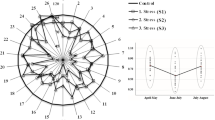Abstract
Chlorophyll fluorescence (CF) is one tool used by researchers to quantify plant water status during periods of limited water availability. The research reported herein was designed to evaluate a CF-based protocol as a tool for use in cotton, Gossypium spp. breeding programs for the identification of drought tolerant genotypes. Twenty genotypes were selected to represent diverse and distinct US germplasm pools. Replicated tests were performed in Lubbock and College Station, TX in 2006 and 2007. Dryland and irrigated treatments, as main plots, were applied in a randomized complete block design, split to genotypes. CF measurements were taken at mid-bloom and late bloom growth stages. Source leaf tissue was harvested at predawn and subjected to high temperature incubation with CF measurements subsequently taken hourly for 5 h. Drought stressed plants had not mobilized their carbohydrate reserves from their source leaves overnight and thus maintained cell viability and therefore higher CF values throughout the incubation and measurement period with the opposite being true for non-stressed plants. Fiber lint yield and fiber properties were measured for comparison with the CF data. Genotype × treatment effects complicated the classification of genotypic response to drought. Few and inconsistent correlations were found among CF values and lint yield or fiber properties. Data suggested that this procedure provides little potential in selecting plants for drought tolerance when plants are grown under field culture.
Similar content being viewed by others
Abbreviations
- CF:
-
Chlorophyll fluorescence
- CPCSD:
-
California Planting Cotton Seed Distributors
- CSIRO:
-
Commonwealth Scientific and Industrial Research Organization
- CSRL:
-
Cropping Systems Research Laboratory
- DP:
-
Delta and Pine Land
- DS:
-
Drought susceptible
- DT:
-
Drought tolerant
- ELO:
-
Elongation
- FM:
-
Fiber Max
- HVI:
-
High volume instrument
- LB:
-
Late bloom
- MB:
-
Mid bloom
- MIC:
-
Micronaire
- SFC:
-
Short fiber content
- STR:
-
Strength
- Stv:
-
Stoneville
- TAM-MAR:
-
Texas A&M multi-adversity resistance
- UHM:
-
Upper-half mean length
- UI:
-
Uniformity index
References
Ali Dib T, Monneveux PH, Acevedo E, Nachit MM (1994) Evaluation of proline analysis and chlorophyll fluorescence quenching measurements as drought tolerance indicators in durum wheat (Triticum turgidum L. var. durum). Euphytica 79:65–73. doi:10.1007/BF00023577
Bajji M, Bertin P, Lutts S, Kinet J-M (2004) Evaluation of drought resistance-related traits in durum wheat somaclonal lines selected in vitro. Aust J Exp Agric 44:27–35. doi:10.1071/EA02199
Burke JJ (2007) Evaluation of source leaf responses to water-deficit stresses in cotton using a novel stress bioassay. Plant Physiol 143:108–121. doi:10.1104/pp.106.087783
Colom MR, Vazzana C (2002) Photosynthesis and PSII functionality of drought-resistant and drought-sensitive weeping lovegrass plants. Environ Exp Bot 49:135–144. doi:10.1016/S0098-8472(02)00065-5
Dumka D, Bednarz CW, Maw BW (2004) Delayed initiation of fruiting as a mechanism of improved drought avoidance in cotton. Crop Sci 44:528–534
Gowda PH, Baumhardt RL, Exparza AM, Marek TH, Howell TA (2007) Suitability of cotton as an alternative crop in the Ogallal aquifer region. Agron J 99:1397–1403. doi:10.2134/agronj2006.0275
Havaux M, Lannoye R (1985) Drought resistance of hard wheat cultivars measured by a rapid chlorophyll fluorescence test. J Agric Sci Camb 104:501–504
Massacci A, Jones HG (1990) Use of simultaneous analysis of gas-exchange and chlorophyll fluorescence quenching for analyzing the effects of water stress on photosynthesis in apple leaves. Trees (Berl) 4:1–8. doi:10.1007/BF00226233
Maxwell K, Johnson GN (2000) Chlorophyll fluorescence—a practical guide. J Exp Bot 55:659–668. doi:10.1093/jexbot/51.345.659
O’Neill PM, Shanahan JF, Schepers JS (2006) Use of chlorophyll fluorescence assessments to differentiate corn hybrid response to variable water conditions. Crop Sci 46:681–687. doi:10.2135/cropsci2005.06-0170
Paterson AH, Saranga Y, Menz M, Jiang C-X, Wright R (2003) QTL analysis of genotype × environment interactions affecting cotton fiber quality. Theor Appl Genet 106:384–396
Pettigrew WT (2004a) Cotton genotypic variation in the photosynthetic response to irradiance. Photosynthetica 42:567–571. doi:10.1007/S11099-005-0014-1
Pettigrew WT (2004b) Physiological consequences of moisture deficit stress in cotton. Crop Sci 44:1265–1272
SAS Institute (2004) The SAS system for Windows. Release 9.1.3. SAS Institute, Cary
Singh C, Pallaghy CK, Singh D (2006) Phosphorus nutrition and tolerance of cotton to water stress I. Seed cotton yield and leaf morphology. Field Crops Res 96:191–198. doi:10.1016/j.fcr.2005.06.009
Stiller WN, Constable GA, Reid PE (2004) Maturity and leaf shape as traits influencing cotton cultivar adaptation to dryland conditions. Agron J 96:656–664
Stiller WN, Reid PE, Constable GA, Read JJ (2005) Selection for water use efficiency traits in a cotton breeding program: cultivar differences. Crop Sci 45:1107–1113. doi:10.2135/cropsci2004.0545
Tambussi EA, Casadesus J, Munné-Bosch S, Araus JL (2002) Photoprotection in water-stressed plants of durum wheat (Triticum turgidum var. durum): changes in chlorophyll fluorescence, spectral signature, and photosynthetic pigments. Funct Plant Biol 29:35–44. doi:10.1071/PP01104
Timpa JD, Burke JJ, Quisenberry JE, Wendt CW (1986) Effects of water stress on the organic acid and carbohydrate compositions of cotton plants. Plant Physiol 82:724–728
Upchurch DR, Wanjura DF, Burke JJ, Mahan JR (1996) Biologically-identified optimal temperature interactive console (BIO-TIC) for managing irrigation. US Patent 5,539,637, 23 July 1996
Wilson RF, Burke JJ, Quisenberry JE (1987) Plant morphological and biochemical responses to field water deficits. II. Responses of leaf glycerolipid composition in cotton. Plant Physiol 84:251–254
Acknowledgment
Research fully supported by Cotton Incorporated.
Author information
Authors and Affiliations
Corresponding author
Rights and permissions
About this article
Cite this article
Longenberger, P.S., Smith, C.W., Duke, S.E. et al. Evaluation of chlorophyll fluorescence as a tool for the identification of drought tolerance in upland cotton. Euphytica 166, 25–33 (2009). https://doi.org/10.1007/s10681-008-9820-4
Received:
Accepted:
Published:
Issue Date:
DOI: https://doi.org/10.1007/s10681-008-9820-4




